THE SANDS OF TIME
By Valentina Pasquali
A look at how the fates have dealt with those firms that advertised in the October 1987 inaugural issue of Global Finance.
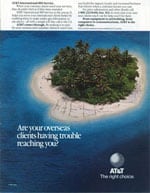 |
|
AT&T was bought by SBC Communications |
Are your overseas clients having trouble reaching you?” queries a full-page AT&T ad that appeared in the very first issue of Global Finance magazine in October 1987. In the background is the image of a tropical island and a cry for help dug by hand, Survivor-style, on a pristine beach.
In 1987, AT&T was still reeling after losing an antitrust case brought by the US government in 1984, and the subsequent end of its telecoms monopoly. This led to the Bell System divestiture—and creations of the Baby Bells, as the smaller, divested regional companies were known. “AT&T had a lot of troubles overcoming its history as a regulated monopoly utility,” says Ken Lipartito, professor of business history at Florida International University. “With a company that massive and a culture so deeply embedded, it took them several CEOs to make any progress.”
Plagued by an unsustainable cost structure and facing growing competition and the increasingly rapid pace of technological innovation, AT&T reinvented itself. The company focused on its core business of network services, long distance and international calls, and manufacturing while also experimenting with different markets. Much of that turned out to be unsuccessful. AT&T’s manufacturing division and much of the famed Bell Labs were spun off into Lucent Technologies in 1996, for example. Finally, in a funny twist of fate in 2005, AT&T Corporation became AT&T Inc after SBC Communications, one of the original Baby Bells, acquired it.
If the history of AT&T is, in a nutshell, a tale about the evolution of an entire industry, the same can be said for the history of many of the other advertisers in Global Finance ‘s first issue. Their stories have intersected with major economic and political developments, mirroring world markets and the economic balance of power over the past 25 years.
END OF THE JAPANESE MIRACLE
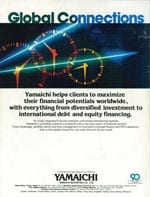 |
|
Yamaichi Securities is now defunct |
When Global Finance came out in the fall of 1987, the world was abuzz with excitement for the Japanese miracle and bets that Japan would overtake the US as the largest global economy. It is no coincidence that several of the companies that advertised in the inaugural issue of the magazine (whose cover title was “Where Japan’s Money Is Going Next”) were Japanese powerhouses. Some of them no longer exist; others have taken new forms. But, overall, their steady decline is a testimony to the tectonic shifts in the global economy since then.
“Yamaichi helps clients to maximize their financial potentials worldwide,” clamored one ad. “Looking toward a listing on the TSE? Contact Chuo Trust, Japan’s leading stock transfer agent,” touted another.
Yamaichi Securities’ run ended abruptly in 1997. “One of the reasons why they went out of business had to do with accounting practices,” says Masao Nakamura, professor at the Sauder School of Business of the University of British Columbia. During the asset price bubble of the late 1980s, Japanese securities companies became accustomed to promising their corporate clients high fixed returns on risky investments. After the bubble burst in 1990, however, this practice was no longer sustainable—in fact it was banned in 1991. But several companies, including Yamaichi, persevered, accumulating huge losses, which they hid by moving to overseas subsidiaries (a so-called Tobashi scheme). The discovery of Tobashi schemes led to the downfall of many such firms.
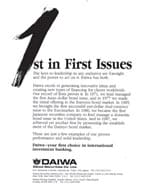 |
|
Daiwa Securities is one of three brokerage firms left in Japan |
But the real reason behind the failure of Yamaichi Securities, along with many others, was the state of the economy. “Japan was going through a period of great economic weakness; the lost decade became the lost two decades, and overwhelming competition in the financial field meant that consolidation had to take place,” explains professor George Olcott of Cambridge Judge Business School. “The scandals weakened companies, but it wasn’t the scandals that caused the bankruptcies—it was the changing economic environment.”
Chuo Trust survived as an independent entity a bit longer than Yamaichi but merged with Mitsui Trust in 2000. The newly created Chuo Mitsui Trust & Banking later joined forces with the Sumitomo Group, another of the country’s conglomerates—known as keiretsu.
The last of the Japanese advertisers in Global Finance ‘s first issue was Daiwa Securities. Itself long affiliated with Sumitomo, Daiwa managed to stay afloat through all of the market’s ups and downs and, after splitting from Sumitomo in 2010, is now independent.
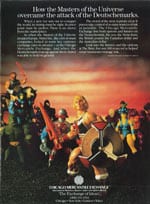 |
|
CME Group is still going strong |
It is one of three securities brokerage firms left in Japan, with Nomura and Nikko, and continues to advertise on GFMag.com. “Daiwa’s is quite a different story,” recalls professor Nakamura. “They suffered from the burst of the bubble but in different ways, because they had better corporate governance and a strong connection with Mitsui Bank [now Sumitomo-Mitsui].”
Japanese corporations learned a number of lessons from the long downturn. “Traditionally they have been known to ignore the wishes of shareholders,” explains Olcott. “But since the late 1990s foreign ownership has steadily crept up.” Foreign shareholders tend to be more demanding than their Japanese counterparts, and as a result Japanese companies are more responsive today.
But Japan is a shrinking market, the economy is not growing like in the past, and there are no particular prospects for future growth, says Olcott. “Japanese companies look overseas for opportunities, particularly across Asia, Vietnam, India, China and now Burma.”
LIBERALIZATION AND GLOBALIZATION
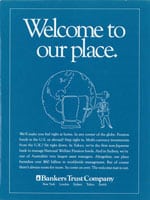 |
|
Bankers Trust was bought by Deutsche Bank |
The bulk of Global Finance ‘s first advertisers comprised US companies, like the Chicago Mercantile Exchange, the Bankers Trust Company (acquired by Deutsche Bank in 1998) and financial services giants like Citibank, Merrill Lynch (now part of the Bank of America franchise) and J.P. Morgan. David Sicilia, professor of business history at the University of Maryland, recalls the dominant mood in the fall of 1987: “It was the height of the deregulation movement. The stagflation of the 1970s had led to a strong push to open up the financial system and give big firms more flexibility in the products they offered and the kind of companies they could merge with, so that by the mid-1980s the whole sector looked very different from even 10 years before.” After all, 1987 was the year that Oliver Stone’s Wall Street came out in theaters, featuring Michael Douglas’s acclaimed interpretation of master of greed Gordon Gekko.
But the great process of liberalization, and parallel globalization, that made people rich in the 1980s also led to the major downturns of the past two-and-a-half decades: the Savings and Loans crisis, the crash of the dot-com bubble and the Long-Term Capital Management crisis in the US; other crises in Japan, Mexico, East Asia, and Russia; and, more recently, the financial crisis of 2008–2009. “The US Federal Reserve became a sort of world central bank, and its low-interest-rate policies had a role in fueling both booms and busts,” says Richard Sylla, professor of the history of financial institutions at the Stern School of Business of New York University. “Globalization also encouraged all sorts of bank mergers, so that banks got larger and larger, and ‘too big to fail.'”
“What has happened shows that Jamie Dimon, like Chuck Prince before him, finds it difficult to manage such a large and far-flung operation”
– Richard Sylla, Stern School of Business, NYU
END OF GLASS-STEAGALL
It wasn’t just banks however. In 1998, what was then Citicorp merged with Travelers Group, a financial services giant with interests from investment banking to insurance. The merger violated the Glass-Steagall Act, legislation enacted during the Great Depression to separate the activities of commercial and investment banks. However, Glass-Steagall was repealed in 1999 and the merger allowed.
 |
|
Citicorp banks on hedging strategies |
“In retrospect it seems to have been a bad strategy for Citi,” says Sylla. “It did not generate all the synergies CEO Sandy Weill and others said it would and created a much larger institution that was difficult to manage.” Many have faulted the repeal of Glass-Steagall for the recent financial crisis, because it allowed already large banks to become even larger.
Just over 10 years after becoming the largest bank in the world, burdened with heavy exposure to collateralized debt obligations (CDOs), Citigroup—which had appeared in the first issue of Global Finance with an ad that asked, “How worried do you have to get before you call Citicorp about a hedging strategy?”—found itself in desperate need of a hedging strategy of its own and was rescued by the US government. “It is a bit ironic that a firm that was always pushing the envelope ended up needing one of the biggest government bailouts ever,” says University of Maryland’s Sicilia.
Merrill Lynch touted its “global leadership in capital markets” in its Global Finance ad. It was acquired by Bank of America in 2009.
For a while everybody pointed to J.P. Morgan as an example of a large investment bank that managed to weather the storm relatively well. At least until recent revelations about the bank’s London desk’s risky bets and $2 billion losses. “What has happened shows that Jamie Dimon, like Chuck Prince before him, finds it difficult to manage such a large and far-flung operation,” says Sylla.
 |
|
Merrill Lynch before Bank Of America took it over |
The lesson seems to be that many factors determine the fate of companies: good corporate governance; the ability to respond to and take advantage of innovation breakthroughs; their interaction with governments and regulations. Some of it, though, appears to be just luck—being in the right place at the right time, so that the global economic tide lifts you up and carries you along instead of capsizing you, as it did Japanese companies in the 1990s.
If advertisements in Global Finance are a barometer of the global economy, looking at the most recent issues of the magazine, we know that the world today is more integrated than ever, and centers of financial power have multiplied and spread out. Alongside older players like the Americans and the Europeans, we now see the Gulf and Asian countries as well other emerging economies worldwide.



